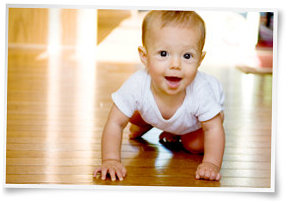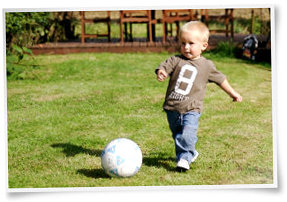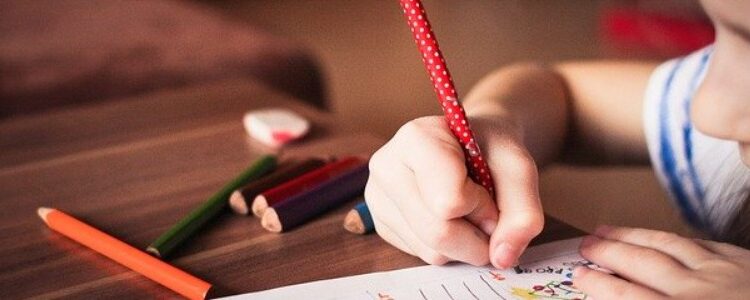Early Childhood Development: Gross Motor Skills
Gross motor skills involve movement of the large muscles in arms, legs, and torso. Gross motor activities include walking, running, skipping, jumping, throwing, climbing and many others. It may be easiest to think of “gross motor” skills as skills most utilized in a gym class or on a playground.
Gross motor skills also include small movements of the large muscle groups. There are always a few children in every preschool or kindergarten classroom who suddenly fall out of their chair during a lesson. In each case, the child was probably shifting his weight, but inadvertently moved his leg, hip or torso muscles too much, causing him to fall out of his chair.
Preschool and kindergarten children need strong gross motor skills so they can engage in age-appropriate physical activities (such as running, climbing, and throwing) and so they can participate in classroom activities that require body control (such as walking in a crowded room or sitting still during a lesson).
In this section, I will discuss:
- What bilateral integration is and how it relates to gross motor development;
- Why bilateral integration is essential for success in reading and writing;
- Tips for accelerating your child’s gross motor skill development; and
- What gross motor skills your child will be expected to have in preschool and kindergarten.
What is Bilateral Integration?
Bilateral integration is a fancy term that refers to the ability to smoothly perform actions using both sides of the body simultaneously. Successful gross motor movements are a result of bilateral integration.
There are several stages of bilateral integration that develop in sequence:
- Symmetrical Bilateral Integration. Symmetrical bilateral integration involves both sides of the body working in mirror-image unison, where the actions on one side of the body mirror the actions performed on the other side.

- Reciprocal Bilateral Integration. Reciprocal bilateral integration involves moving both sides of the body at the same time in opposite motions.

- Asymmetrical Bilateral Integration. Asymmetrical bilateral integration involves each side of the body acting in a different way to complete a single specific task. For example, one foot may kick a ball as the other foot plants on the ground and balances the body.

- Crossing the Midline. The “midline” is the imaginary line down the center of your body from the top of your head to your toes). Crossing the midline involves instinctively reaching across your body to complete an activity.

Importance of Bilateral Integration in Reading and Writing
Successful writing depends on well developed asymmetrical bilateral integration and an ability to cross the midline. First, a child must use one hand to control the pencil and the other hand to position and stabilize the paper (asymmetrical bilateral integration). Then, a child must use one hand to write words along the entire horizontal length of the page, without switching the pencil from the left hand to the right hand at the mid-way point of the page (crossing the midline).
Without well developed asymmetrical bilateral integration or an ability to cross the midline, a child will limit his drawing to the portion of the paper closest to his writing hand since he cannot comfortably reach his hand to other areas of the paper and his non-writing hand does not instinctively readjust the paper’s position.
Successful reading depends on an ability to cross the midline. When reading, a child’s eyes must follow along the entire horizontal length of the page, before moving to the next line.
Without well developed bilateral integration, a child will likely read the first few words on a page and then pause. After thinking for a moment, he may continue to read the second half of the page. This pause is because the child was unable to instinctively cross the midline so he needed to pause and needed to deliberately move his eyes to the next word to resume reading.
Tips for Accelerating Your Child’s Gross Motor Development
Strong gross motor skills depend, in large part, on strong muscles. Muscles gain strength through repeated activity and practice. To accelerate your child’s gross motor development, focus on providing your child with opportunities to engage in focused gross motor activities such as first marching in a straight line. Once he is comfortable with that basic skill, direct him to march forwards while tapping his left knee with his right hand and his right knee with his left hand. This type of activity directly promotes bilateral asymmetrical integration and crossing the midline skill development.
Next time you are outdoors with your child, roll a large ball towards your child while he stands in place. Instruct him to kick it back without stopping it first. As he gains comfort with this activity, have him walk (and later run) towards the ball as it rolls towards him. This type of activity involves advanced asymmetrical bilateral integration as well as coordination.
Learn More About What Will Be Expected of Your Child in School
Children are expected to begin preschool with basic control over the large muscles in their body (the arms, legs and torso) but without finely tuned control over these muscles. For example, a child in preschool may be able to walk up and down the stairs, but may place two feet on each step before moving to the next step, instead of placing only one foot on each step. Also, a preschooler may be able to hold a large bin of markers but may accidentally spill it when trying to walk while holding it.
As children progress through preschool and kindergarten, teachers expect that they will gain increased control over all large muscles in their bodies and be able to execute precise movements such as skipping, hopping, climbing, carrying large objects while walking, walking up and down stairs placing only one foot on each step and sitting cross-legged for up to thirty minutes.
Expectations and Milestones – Gross Motor Skills
Beginning of Preschool
When children enter a preschool program in the fall, teachers will expect them to have control over their large muscles groups, those in their legs, arms and torso. This includes understanding the boundaries of their personal space and being able to avoid accidental collisions with other children, furniture or walls. While this last part may sound funny, any teacher of young children will tell you that there are always a few children each fall that do not yet understand the boundary of their personal space and are constantly bumping into people and things.
Children are expected to walk in a single-file line, without touching the children behind or in front of them and without touching the tempting bulletin boards lining the hallway. As children walk single-file during this early part of the year, it is typical to see big gaps of space between children in line, as many children are not accustomed to walking at a pace set by another person.
Teachers expect that students will be able to sit comfortably and attentively for approximately 15 minutes. This may occur while a story is being read or a lesson is being introduced. During this time, children are expected to be able to keep their hands and legs still and away from other children. Also, children are expected to remain seated for the entire 15 minutes without repeatedly swinging or twitching their legs or standing up to stretch. Many children may still have difficulty maintaining focus and eye contact with the teacher during the entire 15 minutes.
After a few weeks of school, having been introduced to the materials in the room, children are expected to handle school materials with ease. This includes moving baskets or bins containing toys, games or other learning supplies without routinely dropping or spilling the contents. During this early part of the year, as the children learn about the different tools in the classroom, it is still common for children to have difficulty maneuvering a bin that was unexpectedly heavy and accidentally spill the contents.
On the playground or in gym class, children should be comfortable running, jumping on both feet, kicking a stationary ball, and throwing from a stationary position. Many children will begin the year already comfortable with more advanced gross motor skills such as skipping, galloping, kicking a moving ball and throwing while running. For other children, those skills may be just emerging. Children should be comfortable walking up and down stairs unassisted. Some children may place two feet on each step before stepping onto a new step with the leading foot. This is normal. Some children may also need to hold the handrail for added support.
Beginning of Kindergarten
At the beginning of kindergarten, teachers expect that children will be able to sit quietly for approximately 25-30 minutes without becoming restless. This includes sitting with their hands in their lap or on the table in front of them and not allowing their legs to swing or tap. Children may not yet be able to maintain eye contact with the teacher for the full 25-30 minutes, but they should develop this skill within the first few weeks.
When lining up at the end of the day or to walk to a special classroom, children are expected to stand in front of and behind classmates without bumping, pushing or touching their peers. While walking in a line through the halls, they are expected to not only control their own bodies, but also keep an equal and constant amount of distance between themselves and the child in line in front of them. Children should not need reminders while walking and teachers will likely not walk alongside the children to monitor them and will, instead, walk at the front of the line only.
Children are expected to handle large bins or baskets with ease. Even when working with a tub or basket for the first time, children should know to first look inside and then to assess the weight of the materials inside the basket so they can anticipate the heaviness or lightness of the basket. As a result, there should be few, if any, accidental spills.
The majority of children at this age will walk up and down stairs smoothly by placing only one foot on each step. Some children may still need to hold a hand rail for support, but they should be able to reach for the rail themselves and not require an adult’s hand. All children will be expected to comfortably engage in gross motor activities, such as running, climbing and playing on playground equipment. Children should be able to climb up a 4- or 5-rung ladder with ease or use a teeter-totter (pushing off with both feet simultaneously as they near the ground).
Soon after the start of the kindergarten year, teachers hope that their students will know and accurately name the right and left sides of their bodies.
